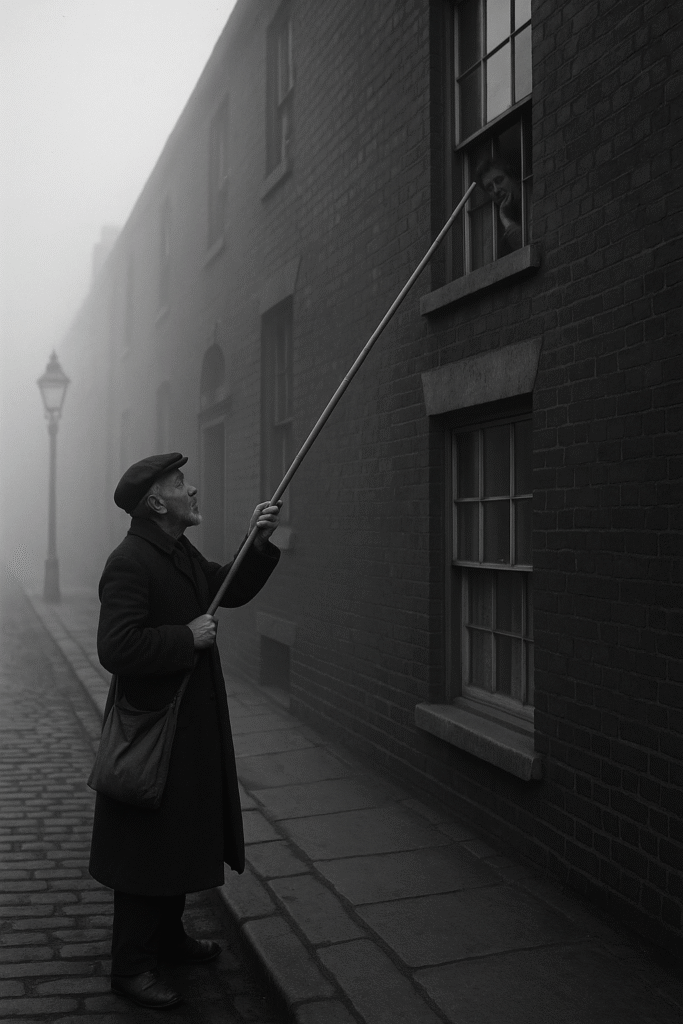Just a century ago, there were professions as curious as “human alarm clocks” who tapped on windows with long poles, or lamplighters who roamed the city each night. Take a trip back in time to explore the jobs that technology has erased from the map.
Human Alarm Clocks

One of the most fascinating cases is that of the so-called “human alarm clocks” or knocker-uppers. Armed with long sticks, bamboo canes, or even blowpipes that shot small pebbles, these workers would walk the streets at dawn to make sure their clients woke up in time for work. This job was common in cities like London, Manchester, and Dublin well into the first half of the 20th century, especially in working-class neighborhoods where being late could mean losing your job.
Lamplighters
Before the arrival of electricity, street lighting depended on gas-powered lamps. Every evening, a worker would make the rounds with a long pole to manually light each lamp, then return at dawn to extinguish them. The role required punctuality, physical stamina, and detailed knowledge of the streets. The introduction of electric lighting with automatic switches made this profession vanish quickly by the 1920s.
Manual Telephone Operators
Before automatic dialing, every phone call had to be connected manually by a switchboard operator. These workers—often women—handled large panels filled with cords and plugs to link one caller to another. Although repetitive, it required speed, sharp memory, and impeccable manners. By the mid-20th century, advances in communications technology had eliminated the need for this role.
Rat Catchers

In an era when pests were a constant threat and modern pesticides didn’t exist, many cities employed professional rat catchers. Equipped with cages, traps, and sometimes trained dogs, they worked to reduce rodent populations and prevent diseases like the bubonic plague. Today, pest control is carried out using more specialized, regulated methods as part of public health systems.
Slide Projector Operators
In early 20th-century movie theaters and stage productions—before digital projection and synchronized sound—there were slide projector operators. Their job was to manually insert still images to accompany performances or advertisements. The role required coordination with the stage crew and quick timing to make smooth transitions. The rise of sound film and television soon rendered the position obsolete.
Traveling Knife Sharpeners
Although they can still be found in some rural areas as a novelty, traveling knife sharpeners were once a common sight in towns and cities. Using modified bicycles or carts equipped with grindstones, they offered sharpening services for knives, scissors, and tools. The availability of cheaper, disposable utensils caused demand to plummet.
Technology as the Driving Force of Change
While each of these jobs has its own story, they all share the same fate: being replaced by technological innovations or structural changes in society. Human alarm clocks disappeared with the mass production of affordable clocks, lamplighters gave way to electricity, telephone operators were replaced by automated systems, and rat catchers became part of modern public sanitation programs.
This process is still happening today. Jobs like toll booth operators, video rental clerks, and photocopy machine attendants are disappearing, while new careers in artificial intelligence, renewable energy, and the digital economy are expanding rapidly.
More than just historical curiosities, these vanished occupations show humanity’s ability to adapt to new realities. The disappearance of certain jobs doesn’t always mean loss—in many cases it opens the door to safer, less repetitive tasks with greater growth potential. However, it also serves as a reminder that technological change can leave many workers behind if retraining programs and transition policies aren’t in place.
A hundred years from now, our grandchildren may be amazed that there were once people who manually drove taxis, worked supermarket cash registers, or wrote articles without full assistance from artificial intelligence. The history of work—like the history of humanity—is always in motion.
